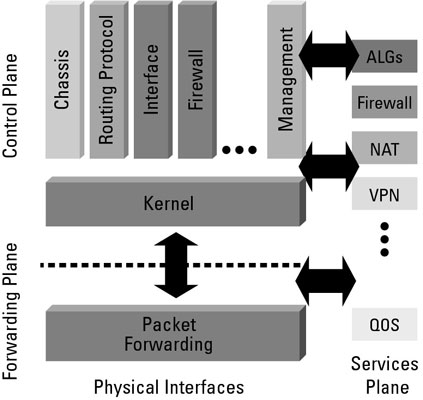The architecture of the Junos operating system cleanly divides the functions of control, services, and forwarding into different planes. Each of the planes of Junos OS provides a critical set of functionality in the operation of the network.
 Control plane of Junos network operating system (NOS)
Control plane of Junos network operating system (NOS)
All the functions of the control plane run on the Routing Engine (RE) whether you have a router, switch, or security platform running Junos.
The high-level design of the control plane consists of a set of modules, with clean interfaces between them, and an underlying kernel that controls the modules and manages all the needed communication back and forth among all the components.
The kernel also handles the RE communications with the Packet Forwarding Engine (PFE) and the services. Each of the different modules provides a different control process, such as control for the chassis components, Ethernet switching, routing protocols, interfaces, management, and so on.
The basis of the Junos kernel comes from the FreeBSD UNIX operating system, an open source software system. This mature, general-purpose system provides many of the essential functions of an operating system, such as the scheduling of resources. To transform it into a network operating system, the Juniper engineers extensively modified and hardened the code for the specialized requirements of networking.
You may be wondering if you have a way in Junos OS to protect the control plane itself from a security attack. Yes, you can configure filters and rate-limit the traffic that reaches your RE.
Packet Forwarding plane of Junos NOS
The Packet Forwarding Engine (PFE) is the central processing element of the forwarding plane, systematically moving the packets in and out of the device. In the Junos OS, the PFE has a locally stored forwarding table.
The forwarding table is a synchronized copy of all the information from the RE that the forwarding plane needs to handle each packet, including outgoing interfaces, addresses, and so on. Storing a local copy of this information allows the PFE to get its job done without going to the control plane every time that it needs to process a packet.
Another benefit to having a local copy is that the PFE can continue forwarding packets, even when a disruption occurs to the control plane, such as when a routing or other process issue happens.
Junos Service plane supports variety of service types
The services plane provides special handling required by many different types of packets. By separating the processing of services from other functions of the operating systems, Junos OS is able to support a wide variety of different service types in different kinds of platforms.
These services might include prioritizing a packet carrying time-sensitive information, such as a voice call, ahead of others on a congested link; guarding which users can get to what sections or applications of the network; translating addresses where one network meets another; or mediating how the network serves video content.
About the Book Author
Walter Goralski is a Senior Staff Engineer and technical writer at Juniper Networks. He has worked in the networking field for more than 40 years. Cathy Gadecki is coauthor of the first edition of Junos For Dummies. Michael Bushong is a Senior Director of Product Strategy at Juniper Networks driving Junos software strategy.
Learn to use JUNOS to make your network reliable!
Providing network administrators with a reliable network operating system, JUNOS software is an award-winning network operating system that focuses on security and the avoidance of down time. This easy-to-understand book starts with the basics of JUNOS and walks you through its features so that you can quickly learn how to set up, operate, and add key services.
Since the various JUNOS features are constantly being updated to provide your network with the best security possible, this new edition shares must-know information, helpful advice, handy tips, and essential cautions for working with JUNOS. Plus, you'll find out how to set up a routing protocol that automates configuration of routing tables for greater efficiency and how you can set up individual or group user accounts locally on the route, or on remote centralized authentication servers.
• Starts with the basics and introduces you to JUNOS
• Explains how to connect, manage, and troubleshoot routers and other Juniper appliances
• Offers tips for making your network more efficient and reveals essential cautions
• Walks you through setting up, operating, and adding key services
• Details ways to configure JUNOS default security features as well as restricted physical access to protect routers
• Breaks down advanced concepts into easy-to-understand segments so you can build your knowledge gradually
This new edition of JUNOS OS For Dummies gets you started using the sophisticated features and techniques of JUNOS today.



